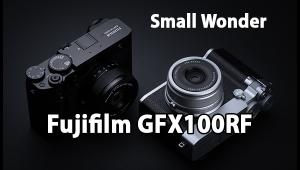Fujifilm X-T10 Field Review: A Portable But Powerful Mirrorless Camera From A Venerable Brand

The 16-megapixel Fujifilm X-T10 mirrorless camera reminds me of the old Reese’s Peanut Butter Cup commercial (bear with me Millennials) where two strangers—one eating peanut butter and one eating chocolate—bump into each other and somehow smash their food together. After a brief bit of yelling (“You got your peanut butter on my chocolate!” “You got your chocolate in my peanut butter!”) they realize that the combination is better than the individual elements.
In this case, Fuji took the professional-aimed performance and imaging found in the Fujifilm X-T1 and combined it with the lightweight, transportable form factor of a “travel” camera to create a system that is in many ways better than the X-T1, from which it hails.
With a price of $800 for the body, versus a $1,300 price for the X-T1 body, the Fuji X-T10 mirrorless camera is clearly aimed at a more budget-conscious customer. Thanks, though, to nearly identical ergonomics between the cameras, identical 16MP APS-C sensors, identical (excellent) image quality, and the ability to use the same range of lenses and accessories, Fuji has created what I feel is the industry’s best backup camera—not just for the Fuji shooter but for photographers in general. Let’s take a look.

Build & Controls
Budget cameras always come with compromises, and the Fuji X-T10 isn’t unique in that regard, but the compromises made are much fewer than those from other systems and, in most cases, don’t detract much from the overall performance of the system.
Unlike the metal-bodied X-T1, the Fuji X-T10 has a plastic chassis, which makes it less durable, but also makes it lighter. Since the X-T10 isn’t designed to be a professional workhorse, the use of a plastic frame isn’t much of a drawback and unlike many consumer bodies the X-T10 in no way feels flimsy or cheap—in fact it feels like it’s made from metal thanks to the solidity of the build.
Another compromise might be more of an issue for the adventurous photographer: the Fuji X-T10 isn’t weather sealed like the X-T1 is. This limits its usefulness in inclement weather, which, of course, is something that a travel camera might encounter. For the photographer who’s interested in shooting images in gusts of rain or near splashing waves, the X-T10 is not the right choice.
There are also some limitations of the system’s use of an APS-C sensor, though this applies to the X-T1 as well. The native ISO range of the Fuji X-T10 is ISO 200-6400, which expands to ISO 100-51,200.

Practically speaking the image quality above ISO 6400 isn’t usable for anything besides spy footage, and ISO 200 is a very high base sensitivity for daytime photography. While the system “expands” down to ISO 100, I’d rather have a camera with a lower base ISO than one with a higher-end ISO, since (as a pro) I tend to shoot more often when the light is good than when the light is absent.
Fuji managed to put a robust 77-point phase detect system in the X-T10, which tracks subjects as they move across the frame. We found this system to be incredibly functional as long as the subjects stayed within the middle of the frame, where the phase-detection points are clustered.
Another great thing is the built-in flash that’s located forward of the pentaprism. The fact that Fuji could squeeze a flash unit onto the front of such a compact camera makes the lack of a built-in flash that much more obvious on all other compact cameras. All told though, the trade-offs for a go-(almost)-anywhere, do-(almost)-anything camera are incredibly small relative to the value of having such a powerful compact system at all times.
The Fuji X-T10 control dials are my favorite feature of the camera—they allow complete manual control of the system or complete automatic shooting depending on the settings of individual dials. Instead of having a dial with P/A/S/M controls on it, the X-T10 decides which mode it’s in based on which dials are in manual and which dials are automatic modes.
Place the shutter speed dial in auto and the aperture ring (on a lens with an aperture dial) on auto and the camera is in program mode. Set the shutter speed dial to a specific setting and the camera is in shutter priority. Combine that with an aperture setting and the camera is in fully manual mode.
For lenses without an aperture dial, control of the f/stop is still actuated solely by the control dials, which is why we prefer the more professional prime lenses to the company’s bundled kit lens.

The Fuji X-T10 has rearranged a number of key shooting controls, mostly for the better, but some have been located in strange places. Regardless of position, Fuji has tried to make the main controls manual, tactile switches where possible, which is great for the traditional film-era photographer. Shooting with the X-T10 is more like shooting with a film camera than anything I’ve used in years.
Still, there’s some adjustment period. The control for the AF mode (single, continuous, or manual) is located as a switch on the front of the camera on the left side (with the camera up to one’s eye), which means that mode switching has to be done with a second hand during shooting. With a compact camera, it would be great to control all features using only one hand.
The left-most control dial on the top of the Fuji X-T1 is a dedicated ISO dial, but on the X-T10 it is a shooting mode dial. This dial contains the controls for switching between single frame, continuous high and low shooting, two bracket modes, two advanced modes, panorama, and multiple exposure. Unfortunately, Fuji ditched the dedicated ISO dial in order to add this control dial, but I’d have preferred if this shooting mode dial were smaller and they’d managed to make a secondary ISO dial next to it.
The Fuji X-T10 has three programmable ISO groups, each one can have a different range of ISO settings. This allows for quick switches between groups for different lighting conditions. As light conditions or shooting conditions change, I simply switch ISO banks, instead of having to override or reprogram my ISO presets. That’s something most cameras can’t do, and one of the excellent little features in the X-T10.

Autofocus
Until Fuji released a firmware update for the X-T1, the X-T10 had a more advanced AF system than the company’s flagship system. The Intelligent Hybrid AF system in the X-T10 has a mix of focus modes and zones that work in conjunction with the 77-point phase detection to create different AF situations to cover different shooting situations.
I tested these on subjects from moving vehicles to erratically running children and the camera managed to keep up with practically everything I could throw at it. Coupled with the face-detection focus, the camera is exceptionally good at following people as they move erratically around in front of the camera.
Excellent Lens Options
It’s difficult to talk about the image quality and performance of the Fuji X-T10 without talking about the lenses and the reason for that is twofold. First, Fuji has always been known for creating top-end optics and the Fujinon lenses for the X-series cameras are no exception. For the review of the X-T10 I tested the kit 18-55mm f/2.8-4 OIS, the 18mm f/2.0 R, and the Fujifilm 35mm f/1.4 XF R lens.
Least useful is the kit 18-55mm lens, due to the f/4 aperture on the 55mm setting, though this is a good place for a rank amateur to start. I’d recommend buying the body only and coupling the camera with a prime lens to start. Image quality from the kit lens seems just about on par with the two primes, albeit with a bit of distortion, but certainly good for a kit piece of glass.
My favorite lens, by far, is the 18mm f/2.0 R, which produces exceptional images and focuses nearly instantly. The 35mm f/1.4 creates the best focus blur in the APS-C body, but focuses more slowly than the 18mm, making it a great portrait lens, but a less useful all-around lens.
In fact, I coupled the small 18mm f/2.0 R lens and used it with the Fuji X-T10 as a street photography system, holding the camera loosely at waist level and capturing images of people without much notice. It’s a perfect fast and light solution.
Image Quality
Fuji is known for their vibrant blue and green hues and the images from the Fuji X-T10 are no exception. The images from the X-T10 were some of the most vibrant I’ve shot, although as was the case in the era of film, skin tones with the X-T10 often render a bit flat, requiring some post-processing work.
For a landscape camera though, the Fuji X-T10 is hard to beat, and even in the bright sun of midday it was hard to take a bad image. I took the camera to a Fourth of July celebration and the red, white, and blue hues of the commemoration were vibrant and exceptional.
In fact, there’s little the camera does poorly. In low light the images still shine, albeit with some need for post-processing work. Push the ISO above the default ranges and the images really begin to fall apart into a jumble of noise, but that’s always going to be the case with an APS-C sensor.
Even the diehard DSLR photographer would do well to check out the Fuji X-T10 as a backup body for the camera bag, the system to pull out of the bag when all else fails, or to hand to the assistant while the main shoot is happening.
Conclusion
The Fujifilm X-T10 is the perfect camera for the Fuji shooter looking for a lighter and more portable body to fill out their system, but it’s also a perfect body for shooters of DSLRs to boot. While the company made some compromises to create a more compact travel package, none really detract from the usability of the system, and none in any way detract from the excellent image quality of the X-series. With a relatively affordable $800 price tag, the Fuji X-T10 is a no-brainer for the photographer looking for a budget camera with the features and functionality of a pro system, and the lenses and image quality that serious photographers crave.
- Log in or register to post comments

















































